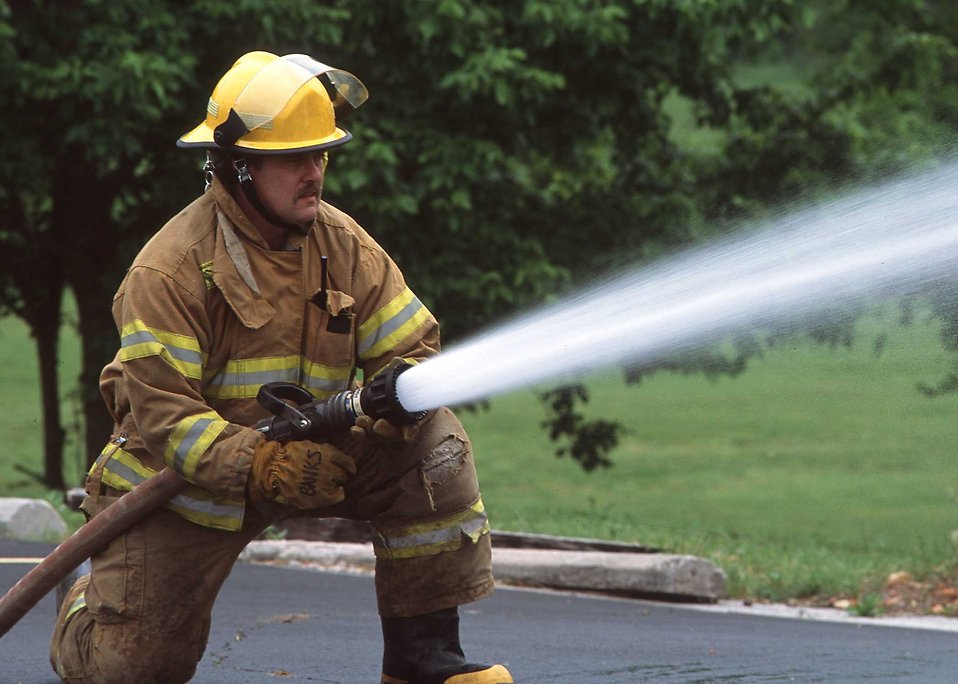There seems to be a fair bit of not-quite thereness to this…
I was an airport firefighter for a long, long time, and now I’m a fire protection engineer.
Flammable liquid firefighting using water based agents (plain water or foam) is concerned with doing two things: vapor suppression and cooling. Water is useless for vapor suppression on nearly all flammable and combustible liquids, as they nearly all have specific gravities less than 1 (they all float). The water sinks to the bottom, and gives the flammable liquid a much nicer surface to travel on.
Water does cool the liquid down. If you can cool a flammable or combustible liquid to below its flash point, the fire will go out. Diesel, kerosene, and Jet A all have flash points in the 105-120F range. Put a spray of water across the surface, the fuel cools down, and the fire shuts off (the same thing happens with a solid fuel - cool to below its ignition temperature, pyrolysis ends, and the fire goes out). This isn’t quick, and the larger/deeper the fire the more difficult it is to make it work. As stated above, water absorbs a metric buttload of heat.
If you direct a straight stream of water into a liquid fire, it churns the fuel up and lifts it into the air, giving the burning fuel more surface area and the fire gets bigger.
Gasoline has a flash point of -44F. You can’t spray water on it to cool it down enough. Water will not put out a gasoline fire (you can sometimes push the fire off the surface of a small gasoline fire, but it usually reignites).
Foam (specifically aqueous film forming foam [AFFF]) is a mixture of water and a surfactant. The surfactant allows the liquid foam solution to maintain a bubble structure when its air aspirated. The surfactant also electrically polarizes the water so that it floats on the surface of the fuel, but as it’s an electrical thing at a molecular level, it’s a very thin layer of water. When this bubble matrix is laid down on the burning fuel, the water leaks out of the bubbles and floats on the fuel beneath.
Foam works in a few ways. It cools like water does (because its 97% water [well, its 94% to 99%, but that’s another thread). More importantly, the floating layer of water suppresses vapors (it puts enough weight on the fuel that it overcomes the fuel’s vapor pressure) and/or separates the fuel from the oxygen in the air. The aqueous layer of water travels super quickly ahead of the bubbles, and gives crazy fast knockdown of the fire. The rapid knockdown is why foam is the agent of choice for airport fire departments.
The downside of the foam layer is that the bubbles lose their trapped water in 3 to 5 minutes. The water that collects on the surface of the fuel, once the layer gets too thick for the electrical thing to hold up, falls through the fuel and acts like normal water. In those 3 to 5 minutes, there isn’t enough of a layer to suppress vapors anymore. Now you need to add more foam.
Extinguishment gets more complicated based on the surface the fuel is on. Oddly, fuel floating in water is the easiest. Pavement isn’t bad. Fuel on soil is horrifyingly difficult to extinguish.
Depth is also a factor. The deeper the fuel is, the longer it generally takes to extinguish. There is also an autorefrigeratiom effect that takes place at the surface. As the fuel vaporizes, it pulls some of the heat from the fuel just below the surface, so fuel temperature below the surface tends to stay pretty stable. Under certain circumstances, fuels in storage tanks can get a heat wave that travels downwards and can cause other problems.
The fluorinated “forever chemical” crisis is part of the surfactant thing for AFFF. Newer fluorine free foams (F3) don’t seem to do the liquid layer thing, and rely solely on the blanket of bubbles to suppress vapors and separate from oxygen. Interestingly, the new foams are working the same as the old protien foams from pre 1970, which were made from fish guts and cow hooves (seriously). Whats old is new again.

